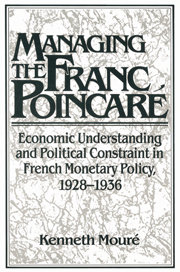 Managing the Franc Poincaré
Managing the Franc Poincaré Published online by Cambridge University Press: 23 November 2009
In 1934 the disparity between French and world prices became a key issue in policy discussion. As indicated in the preceding chapter, French policy makers preferred deflation to devaluation as the means of lowering prices. There were two main reasons for this. The currency was considered a fundamental factor in economic and social order to be kept stable at all cost, and the budget deficit was believed to be the source of French economic difficulties, its elimination the necessary first step to recovery. Until 1933, devaluations abroad had little impact on French opinion. The depreciation of sterling in 1931 immediately affected the relation between French and British prices; Sauvy's statistics show French wholesale prices roughly 12% lower than British prices through the first eight months of 1931, with the ratio then switching in Britain's favor, French prices averaging 20% higher from 1931 to 1936. French governments were certainly not unaware of the difficulties created by this price disparity, but they were interested primarily in the reasons for devaluations, rather than their effects, in order to draw lessons for defense of the franc. The results of such inquiry were encouraging; Britain had been forced off gold for reasons that France, with strong gold reserves and little foreign lending, had no need to fear (see Chapter 2).
The depreciation of the U.S. dollar raised concern that French goods would be unable to compete with those priced in depreciated currencies. Devaluation was then suggested by several economic commentators on the moderate left of French politics. It remained a fringe option, however, without serious support, until Paul Reynaud advocated devaluation in 1934.
To save this book to your Kindle, first ensure [email protected] is added to your Approved Personal Document E-mail List under your Personal Document Settings on the Manage Your Content and Devices page of your Amazon account. Then enter the ‘name’ part of your Kindle email address below. Find out more about saving to your Kindle.
Note you can select to save to either the @free.kindle.com or @kindle.com variations. ‘@free.kindle.com’ emails are free but can only be saved to your device when it is connected to wi-fi. ‘@kindle.com’ emails can be delivered even when you are not connected to wi-fi, but note that service fees apply.
Find out more about the Kindle Personal Document Service.
To save content items to your account, please confirm that you agree to abide by our usage policies. If this is the first time you use this feature, you will be asked to authorise Cambridge Core to connect with your account. Find out more about saving content to Dropbox.
To save content items to your account, please confirm that you agree to abide by our usage policies. If this is the first time you use this feature, you will be asked to authorise Cambridge Core to connect with your account. Find out more about saving content to Google Drive.